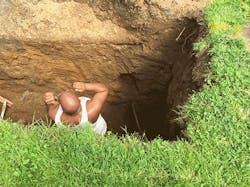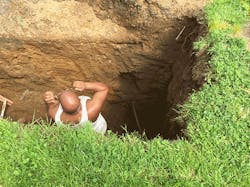I’m working from home today due to a busted sewer line on the city’s property. The good news is that it is the city’s problem and it will be repaired at no cost to me. The bad news is that it’s a busted sewer line and it was discovered when my basement flooded with toxic waste.
The contractors who were sent out to dig up the line brought heavy equipment, but because of the size of the treelawn (about five feet deep and 40 feet wide) and the close proximity of the gas line, most of the digging has been done by hand. In an unsupported, 10-foot-deep trench.
I didn’t realize it was unsupported at first. They unloaded a bunch of lumber that only could be used for supporting the walls of the trench. And it’s been in a pile in my driveway ever since.
The supervisor came out to check on the crew. I met him outside and stood next to him as he watched them dig. He casually said to them, “You should support the walls of that trench. They’re sand.”
And they ignored him and he didn’t insist.
As a bystander, and someone who is functionally knowledgeable about trenching hazards, I know that this is a dangerous situation. The soil is sandy and collapsing back into the hole as they dig.
As I weighed my desire to keep them safe against my desire for them to continue working so that my sewer is repaired as quickly as possible, I realized – first hand – how difficult it is to place safety over production.
But really, when lives are at stake, do we have a choice?
I finally was forced to pull the “I’m calling OSHA if you don’t get out of that trench and shore it up” card when I realized the supervisor had left and one of the workers was 10 feet down in the unshored hole.
Let’s just say I’m not their favorite person right now. And that’s okay. I explained why I was concerned. And I asked them if they wanted to go home tonight or go to the hospital or worse, the morgue. I told them that knowing what I know, I couldn’t allow them to continue working unsafely.
If you see something, say something always has been my motto. And maybe the next time, when these guys are on another job, they’ll think about what I told them and decide to work safely.
About the Author
Sandy Smith Blog
Content Director
Sandy Smith is content director of EHS Today. She has been writing about occupational safety and health and environmental issues since 1990. She has been interviewed about occupational safety and health for national business publications,documentaries and television programs, has served as a panelist on roundtables, has provided the keynote address for occupational safety and health conferences and has won national and international awards for her articles.

